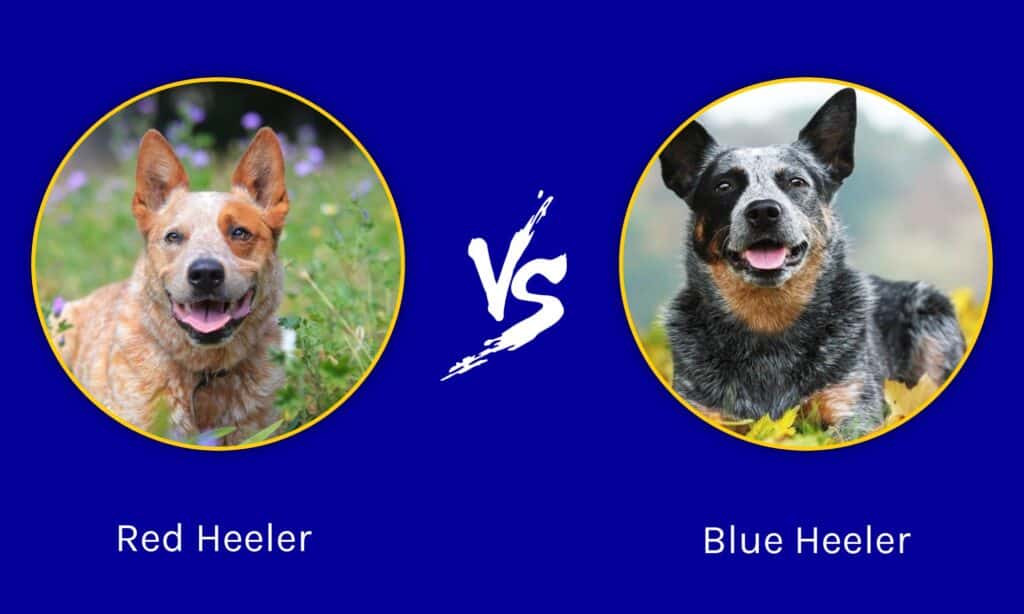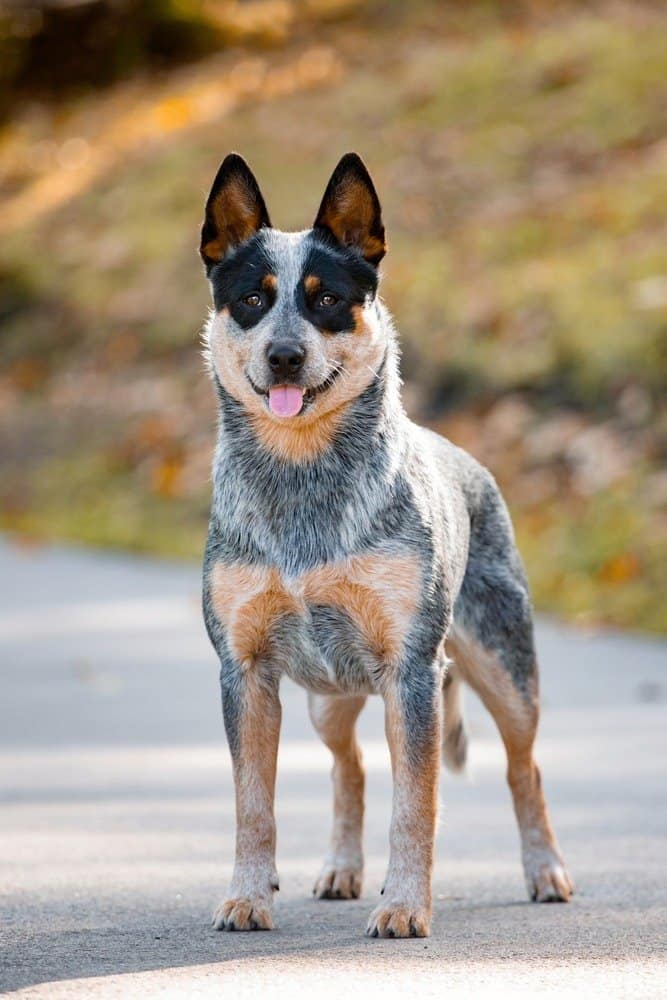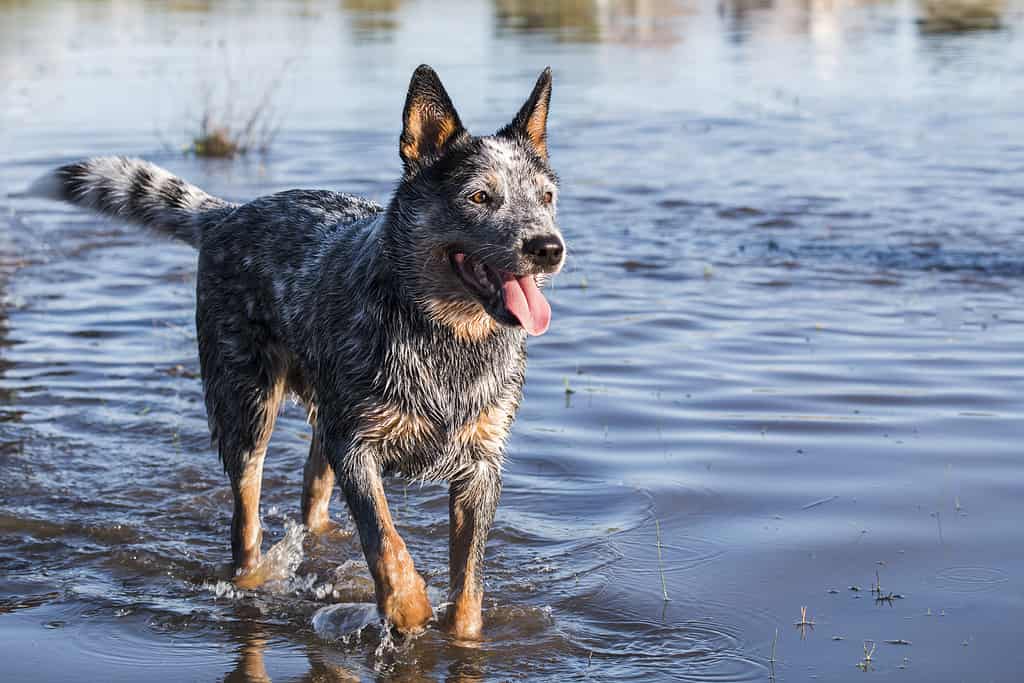Blue Heelers and Red Heelers are both Australian Cattle Dogs. An Australian cattle dog is the result of breeding a blue merle collie with a dingo. Both Blue and Red Heelers have white speckling, tan patches, and sometimes a cute white patch on their head known as the “Bentley.”
Keep reading to learn more about this herding breed, where it gets its names, and how the Blue and Red Heelers differ from one another.
Comparing Red Heeler vs Blue Heeler

| Red Heeler | Blue Heeler | |
|---|---|---|
| Size | 17-20 inches, 35-50 pounds | 17-20 inches, 35-50 pounds |
| Appearance | Short double coat with red mottled or red speckled pattern; can have red or tan markings | Short double coat with blue, blue mottled, or blue speckled pattern; can have tan or tan and black markings |
| Lifespan | 13-15 years | 13-15 years |
| Temperament | Protective, energetic, and intelligent | Protective, energetic, and intelligent |
| Energy | High-energy | High-energy |
| Training | Easy | Easy |
| Grooming | Once weekly | Once weekly |
Key Differences Between Red Heeler and Blue Heeler
The only difference between the Red Heeler and Blue Heeler is their color. Blue Heelers are dark in color with blue-black fur, while Red Heelers are primarily an orange-brown color.
Keep reading to learn more about their coats and the Australian Cattle Dog breed as a whole!
Red Heeler vs Blue Heeler: Size
Australian Cattle Dogs stand at 17-20 inches tall and weigh 35-50 pounds. There is no size difference between the Red heeler and Blue Heelers. However, there is a height difference between males and females. While females measure 17-19 inches, males are 18-20 inches tall.
When determining if this breed is right for you, it’s important to think about costs. This breed is rather large and will require a larger food and veterinary budget than smaller breeds. Australian Cattle Dogs also require a large backyard to play and run around in. It should be well-enclosed so they cannot escape, as they do have a tendency to roam.
Red Heeler vs Blue Heeler: Appearance

Red and Blue Heelers look the same aside from their coloration.
©WOLF AVNI/Shutterstock.com
This is where the difference between these dogs comes into play, so let’s get into it!
Both the Red heeler and Blue Heelers have a short double coat. They’re compact in appearance, with short legs compared to their long backs, a mid-length snout, and round, soulful eyes. Their ears stand upright naturally.
Blue Heelers can have several fur patterns: blue, blue mottled, and blue speckled.
The blue coloration has black fur and white fur growing together, creating a smooth look. Blue-mottled dogs have small patches of white hair amongst their black fur, while blue-speckled Heelers have small patches of black fur growing amongst a white coat.
When it comes to Red Heelers, they have two coat types as described by the American Kennel Club (AKC) breed standard: red mottled and red speckled.
Red-mottled Australian Cattle Dogs have white hairs growing through the red coat, while red-speckled dogs have patches of red amongst a primarily white coat. Australian Cattle Dogs can have markings of tan, black, and tan, or red.
Blue Heelers can have these markings on the head. There should be a tan color halfway up the front legs, also covering the dog’s chest, throat, and jaw. Also, the inside of the dog’s hind legs and thighs is tan. Breed standard allows for a tan undercoat as well but specifies it shouldn’t show through the outer coat.
Red Heelers should have even coloration throughout the body, including the undercoat. They may have darker red on their face and body, but the AKC preference is even markings on the head and none on the rest of the body.
Red Heeler vs Blue Heeler: Lifespan
Luckily, both colors of Australian Cattle dogs are long-lived at 13-15 years. Of course, this is an average, so some dogs will live shorter lives while other lucky pups will live much longer.
The oldest dog ever recorded was actually a Blue Heeler named Bluey, who lived to be 29 years old! If you want your Heeler to live a long life like Bluey, there are a few things you can do to keep them healthy and happy. This includes feeding a well-balanced diet, exercising them daily, and bringing them in for regular check-ups at the veterinarian.
Genetics and health also play a role in how long your pup lives, so of course, it’s not always completely in our control. All we can do is provide our dogs with the best lives possible!
Red Heeler vs Blue Heeler: Temperament
Heelers are protective, energetic, and intelligent. They were bred to herd livestock, have a strong hunting instinct, and love to run! This can make them difficult to keep tabs on, so it’s important to enclose them in a safe, dog-proofed backyard. The fence should be tall to prevent escape.
They must also get enough exercise, or you’ll begin to see problematic behaviors like excessive barking or destructive chewing.
Australian Cattle Dogs love their family and will protect you, your pets, livestock, and your home. Train your pup well so that these instincts don’t turn toward aggression or fear toward strangers.
Red Heeler vs Blue Heeler: Energy

Australian Cattle dogs are long-lived, easy to train and have moderate grooming requirements.
©Vera Reva/Shutterstock.com
Heelers are incredibly intelligent. This makes them easy to train but means their minds must be occupied by a variety of activities. Mental enrichment and continuous training is a must.
When it comes to physical exercise, these are high-energy dogs. They thrive when given a job to do, and daily walks aren’t enough. Long runs every day will help to get out their energy; if you’re not quite so energetic, be sure to give them an enclosed area to get their zoomies out!
Don’t leave them all alone in the backyard, but instead engage them in games. Fetching a ball or flying disk is a great way to get them running. You can also use a flirt pole as a lure for them to chase!
Red Heeler vs Blue Heeler: Training
Australian Cattle dogs are intelligent and eager to please. They should be a breeze to train—for the most part. There are a few things to watch for. First is their guarding instinct. Socialize your pup early in life so they don’t learn wariness toward strangers. You want them to protect your home, but no one wants their dog to grow up aggressive or fearful.
Next, Red Heelers and Blue heelers have a tendency to nip heels. You’ll want to train them out of this early on—don’t allow it when they’re puppies, no matter how cute they seem. Trust that it won’t be as adorable when they’re a grown dog nipping at the heels of a child or guest!
Walk away and disengage when your pup nips. Don’t punish them; remember, they’re only doing what they’re bred for. Herding dogs often nip the heels of livestock to keep them in line, and when they don’t have farm animals to herd, they might try it out on you, your kids, or your pets.
Lastly, Heelers may run off if allowed off-leash in an unenclosed space. This is because they have a strong urge to chase and hunt. Their prey drive can get them in trouble, and often reliable recall is tough or impossible to teach.
Keeping them on a leash or enclosed at all times is your best bet. It’s not worth the risk of losing your dog if they race into traffic, sprint so far away you can’t find them, or encounter another threat.
Red Heeler vs Blue Heeler: Grooming
Australian Cattle Dogs have a short double coat that sheds moderately and requires weekly brushing. A quick brush through their fur should do the trick to remove loose hairs. This will also keep the fur healthy and sleek by distributing your dog’s natural oils.
Twice a year, usually during the spring and autumn months, your Heeler will shed their undercoat. This will lead to a greatly increased amount of shed fur, and your pup will need more brushing to keep up with it.
During shedding season, Australian Cattle Dogs should be brushed once every few days. You might also need to comb their fur. These grooming sessions will take longer due to the increased shed, and you’ll likely notice more fur around your house as well that’ll need cleaning!
Bonus: Are Heelers Aggressive?

Blue heelers received their name for their instinctive behavior of nipping at the heels of the cattle they herd.
©Madelein_Wolf/ via Getty Images
You may have been wondering where the “heeler” got its name. Obviously, its blue fur answers part of that question. “Heeler” was a label ascribed to this breed because of its behavior of nipping at the heels of the cattle it herds.
Unfortunately, these dogs are capable of exhibiting the same actions toward humans they are unfamiliar with. In fact, they have a reputation for biting people. There are many tales to support the fact that they will resist allowing a guest to leave their home, aggressively attacking their heels. This behavior may be sparked by a desire to cause harm, but could also be instinctual, based on the fact that blue heelers do this on a regular basis as part of their job.
It’s important to remember that Australian cattle dogs in general are instinctively aggressive in terms of being confident, able herders, so some of their behavior can be misconstrued. It’s also true that a dog of any breed can be aggressive based on how it’s treated by humans. A dog that has been kicked or hit regularly is more likely to show aggression as a form of retaliation towards people than one that is treated with love and kindness.
Heelers are extremely loyal and protective of their owners and make good family pets. If treated well, they can make wonderful companions.
The photo featured at the top of this post is © iStock.com/Carmelka
Ready to discover the top 10 cutest dog breeds in the entire world?
How about the fastest dogs, the largest dogs and those that are -- quite frankly -- just the kindest dogs on the planet? Each day, AZ Animals sends out lists just like this to our thousands of email subscribers. And the best part? It's FREE. Join today by entering your email below.
Thank you for reading! Have some feedback for us? Contact the AZ Animals editorial team.






